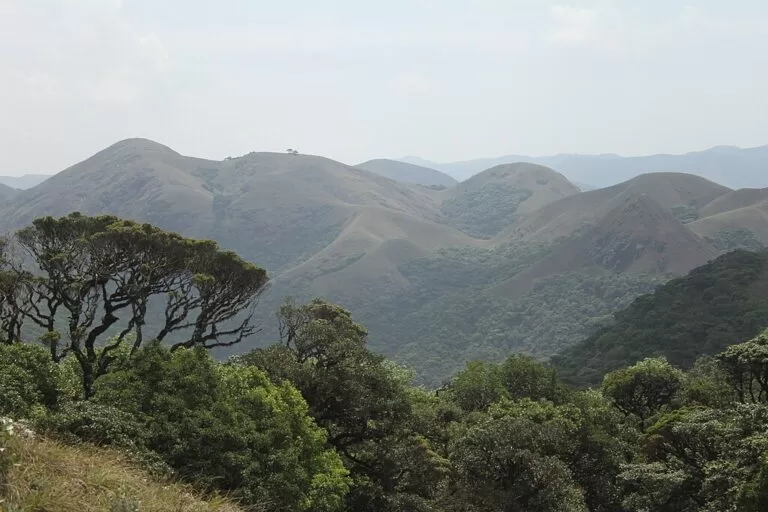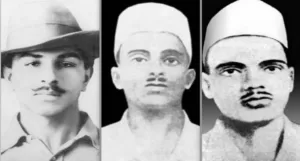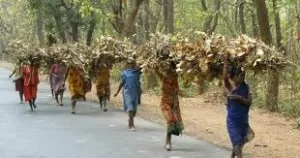The overnight rains had swelled the Kunthipuzha river, the lifeline of the Silent Valley forests, into a wild raging torrent. We were on a trip to Silent Valley to briefly explore the myriad landscapes, gurgling streams, whimsical weather and the mysteries that stalked these strange, dark and foreboding forests. Alarmed by our unexpected presence, a troop of Nilgiri langurs gave vent to loud and raucous calls, startling us, and disturbing the serene silence of these forests.
The year was 1975 and unknown to us, the controversy over the Silent Valley hydroelectric project was just about to erupt. And little did we realise that we too would be swept into a raging altercation over environment versus development. It was mere chance, fortuitous chance, that we were in the right place, at the right time, to tell the outside world about these magnificent and pristine forests and rich and diverse wildlife.
The Save Silent Valley campaign would soon snowball into one of the most controversial environmental campaigns in the country. And we would be among the first few outsiders to have witnessed the magic of these forests. Later, we would do our own research and proudly enumerate the magic of these wild lands where no human habitation had existed for centuries – to the thousands who had stood beside us and fought for the survival of these dark and mysterious forests.
The Save Silent Valley movement triggered the ecological consciousness of thousands of people in Kerala, the tiny sliver of land wedged in the south western coast of India. And soon, its reverberations would be felt across the length and breadth of the country. It was purely a people’s movement, an altruistic one at that, comprising thousands of students, academicians, scientists, engineers and the layperson, as its foot soldiers.
The decade of the 1970s saw the burgeoning of the early environmental movements in India: the Silent Valley, the Chipko, Apiko and the Tehri dam movements among others. The Silent Valley movement stood out most for its altruism. It epitomised the emergence of a new policy divide: the inherent contradictions between economic development and ecological consequences. The lessons learnt would help mitigate the conflict in the years to come and help evolve a roadmap for resolving future conflicts.
The success of the Silent Valley movement kindled the environmental consciousness of a whole generation of people. And as a result, the Ministry of Environment and Forests became a strong regulatory body with far more powers, new environmental guidelines were written into government statutes, environmental impact assessments became mandatory and environmental costs were weighed against development rewards for ascertaining the risks and rewards of all programmes.
However, in the past couple of decades we have increasingly squandered away the policy gains that we had made through these struggles. The checks and balances we had erected in our environment-development paradigm have been eroded.
It was the personal intervention of the former Prime Minister, Indira Gandhi that saved the Silent Valley. She declared a slew of rules and regulations which forced development planners to consider the environmental costs that development projects entailed. She was the first Prime Minister to give credence and validity to environmental issues in the country. And it all started with the Silent Valley Movement.
But it was not the first time. On June 12, 1972, she delivered a rousing speech at the UN Conference on Human Environment at Stockholm, Sweden. She was the first and only woman Head of State to address the conference. And among the first few Heads of State to openly endorse and support environmental concerns on a global stage.
Silent Valley history
The story of the Silent Valley hydroelectric project had a long and chequered history. It was in 1928 that the British first identified the Kunthipuzha in Silent Valley as an ideal location for a hydroelectric project. It took another 30 years for the Kerala State Electricity Board (KSEB) to undertake a feasibility study and survey the area in 1958.
It was only in 1970 that the KSEB declared its intent to build a dam across the Kunthipuzha river and submitted the proposal to the Planning Commission. The Commission gave its interim consent in 1973. In fact, if the KSEB had begun accelerated execution of the project right then, the outcome could have been starkly different. The project envisaged the submergence of 830 hectares of wet evergreen forest in an artificial reservoir to generate 120 MW of electricity, provide irrigation facilities to 10,000 hectares and generate employment opportunities for 4,000 people.
However, the environmentalists feared substantially higher losses: forest cover loss due to the construction of accessibility roads, influx of first-wave settlers through these new roads, loss of area as people encroached the forest land to build homesteads and claim land for agriculture and illegal forest felling with tacit support of government officials. The people had witnessed a similar situation unfold while the Idukki dam was being built further south, about 200 km away.
Sowing the seeds of the Save Silent Valley movement
In 1972, the famous herpetologist Romulus Whitaker undertook a survey of snakes and lizards of the Western Ghats, including the pristine Silent Valley forests. He was charmed by the mystical name of the forests, its unique inhabitants but was alarmed to hear about the potential dam which was to inundate its core areas under water.
He went back and wrote an article in what was then a World Wildlife Fund newsletter titled ‘Save Silent Valley,’ which soon became the rallying cry for thousands of activists and campaigners in their pursuit to protect the valley. The movement against the dam was neither spontaneous nor was it concerted, organised or pre-conceived. It was movement built over the years, starting with small assemblage of people who shared information among themselves, brought greater scientific clarity to issues and disseminated it to the ever widening circle of sympathisers, well-wishers, activists and the people in general.
By the late 1970s, the groups and gatherings began to gain critical mass and momentum. Then, individual groups began to question the veracity of the new dam, pointing to the ecological deluge from previous dam experiences, which had led to massive encroachments and widespread deforestation, severe erosion, soil degradation and ground water depletion.
The small group of students who had visited the Silent Valley in 1975 had, by then, joined the University Centre in Kariavattom, Thiruvananthapuram. The centre of activity for the Save Silent Valley movement had also shifted to the state capital, Thiruvananthpuram.
It was the University Centre that then provided the next ember to re-ignite the movement’s activity. Satheesh Chandran Nair and his wife Shanthi Satheesh were doctoral fellows at the University’s Zoology Department. Both were talented scientists who had extensively studied the Silent Valley forests.
The Silent Valley movement gained further momentum when the students of the Economics Department organised a symposium between the proponents and opponents of the dam. With Satheesh of the University Centre taking on the Chairman of KSEB, the contest was no neck-to-neck battle. And the cause of the valley led by a wide margin. Or at least, the audience seemed to think so. The champions of the valley realised that they had won the first major battle but foresaw a bigger and long drawn out war ahead.
Meanwhile, there were initial moves in Delhi to declare the Silent Valley forests as a National Park. As a prompt counter, the state government issued a notification in 1979, excluding the hydroelectric project from the purview of the proposed National Park. Six years after gaining clearance for the project, there was hardly progress on the ground.
While the State and Centre were engaged in this shadow boxing of nerves and strategy, the proponents for the valley realised that they could not take on the might of the state government nor combat its huge resources, staff, organisational structure or take on powerful institutions like the KSEB. Even the opposition in the state legislature was in support of the dam. The media was also gently pro dam, even as it strived to be even-handed, carrying both viewpoints.
Opposing the dam was a Herculean task. Those opposing realised that they were too fragmented and needed a cohesive organisational support. They had the support of just one organisation, the Kerala Shastra Sahitya Parishad (KSSP). And they needed to bring more individuals and organisations under the umbrella.
The might of the state and the power of a rich and powerful institution like the KSEB with huge material and extensive human resources at its command was pitted against a few individuals of integrity and repute with no organised financial backing.
A formidable battle
After KSSP, what came into immediate focus was the Kerala Natural History Society (KNHS) in Thiruvananthapuram, a quiescent group of young ornithologists who confined their activities exclusively to birdwatching, social behaviour of birds, bird habitats and shifting patterns in bird migrations.
KNHS was led by the avid and well-acknowledged ornithologist and professor K. K. Neelakantan. The professor was a person of great integrity, having gained stature by having accompanied the famous ornithologist Salim Ali on his survey of birds of Kerala and Travancore. However, there was resistance from amongst several members of the Society against moves to assume the role of an activist and campaigner for the Silent Valley.
The next was a loose coalition of poets/writers/artists who voluntarily extended support for the valley and who were pivotal in shifting public opinion by writing and publishing poems and articles in popular magazines and newspapers. The general public soon became intensely aware of the issues involved. The logic of environmental preservation gained currency. The nuances of both pro and anti-dam stances soon became the point of debate and discussion in local tea shops and stores. Something quite unique to literate Kerala of those times. The Silent Valley had burst out of the files and cupboards of the KSEB into the public domain.
Poet Sugathakumari was the force, that bound the people and organisations closer to the cause. Carrying on from where Romulus Whitaker had left off, Sugathakumari teacher, as she was fondly known, followed up on the Save Silent Valley movement. But N. V. Krishna Warrier, a writer and editor whom she looked up to, advised her to rename the organisation to Prakrithi Samrakshana Samithi.
As the name implies, it was not merely a change in nomenclature but of shifting focus: from saving an individual Silent Valley to becoming the guardian of environment and forests in general. The Samithi became the umbrella organisation under which several groups and individuals worked, together and separately, for the cause.
Meanwhile, the movement began garnering attention at the national level. National newspapers started carrying news stories and sometimes editorials. The Hindu newspaper, a staunch supporter, championed the cause of the valley in editorials. The focus of attention began to increasingly shift from the state capital to the national capital.
This was the era when newspapers and magazines were all powerful – the sole dispensers of news, moulders of public opinion, influencing the thought process of bureaucrats, thought leaders and other government officials. New Delhi, a fresh, new, news magazine, published from the national capital was one of the first in covering the Silent Valley controversy.
It despatched its reporter and photographer to do justice to a controversy which was simmering over from the state to the national capital. The duo stayed in Kerala for over a week, went through the voluminous files of KSEB, talked to activists and campaigners and later published a detailed cover story with some gorgeous pictures, championing the cause of the valley. There were other news reports from Delhi too.
The interregnum period between 1973, when the Planning Commission gave sanction to the project, till 1979 when there was hardly much headway in the project implementation, was to prove very critical. This provided the time for the detractors of the project to organise and sharpen their attack. It also provided time for the media to give due and extensive coverage to the controversy. And finally, it gave Satheesh, time to prepare studies and scientific reports on the contentious nature of the project and the environmental sacrifices it would entail.
The thought leaders, bureaucrats, some scientists, and Delhi’s intelligentsia in general began to take notice. One among them was N. D. Jayal, the Joint Secretary in the Ministry of Environment and Forests. There were some research and surveys on Silent Valley and its ecology that Satheesh had been pursuing that caught the attention of Jayal. Things seemed to be moving well for the Valley in Delhi.
The momentum seemed to have set in. The backing for the valley came from an extremely diverse spectrum of scientists: M. S. Swaminathan, V.S. Viijayan, Zafar Futehally and M. P. Parameshwaran to name a few. There was also Salim Ali who had visited Silent Valley during his bird survey of the state and more importantly he had access to the then Prime Minister Indira Gandhi.
By 1979, the chorus for the valley began to build up, even as PM Gandhi was becoming deeply interested and involved in the project. She set up the MGK Menon Commission with Madhav Gadgil and A. Abraham as members to undertake a socio-economic feasibility study of the project. Over two years later, the MGK Menon Committee submitted a report detailing the environmental costs of the project and its economic gains and suggested that the project be dropped. But the last word had still not been said. The final executive decision from the government was still to come.
On the morning of October 18, 1983, newspapers carried the headlines that the Union Government had decided against giving sanction to the project. The environmentalists erupted in joy. But before much progress could be made on the ground, PM Gandhi fell to an assassin’s bullet on October 31, 1984. In just about two weeks after her death, Silent Valley was declared a National Park on November 15, 1984. And on September 7, 1985, the then Prime Minister Rajiv Gandhi dedicated the Silent Valley National Park to the nation and its people.
But the greatest note of approval to the valley and those who fought for it came from the global community. It was in September 1986 that UNESCO declared the Nilgiri Biosphere as a world heritage site where several contiguous and diverse forest geographies of South India met and combined. Silent Valley became part of the core area of the new biosphere reserve. It is not just India’s first biosphere but also the largest one, comprising of 5,000 sq. kms. of topographies and geographies, ranging from the wind swept high altitude grass land shola forests with short stunted trees which can withstand ravages of recurrent summer fires, to wet evergreen, moist deciduous and dry thorny forests.
The biosphere reserve comprised forest cover from the neighbouring states of Kerala, Tamil Nadu and Karnataka. The Kerala stretch comprised some of the thickest and most densely tree covered forests of Silent Valley, New Amarambalam forests of Nilambur, the Attappady forests and lower reaches of the wind swept Kunda forests. While Kerala could boast of the thickest forest canopy, Tamil Nadu contributed the largest area which included Talaimalai Reserve Forest, Nilgiri North and Mudumalai forests. Karnataka also contributed Bandipur and the Rajiv Gandhi National Park.
However, there are fragmented stretches in all these three states where isolated forest patches still survive – fighting against human encroachment, wild fires, threats of inundation through dams and other caprices of development. One of the biggest objective of declaring such a huge piece of forest as biosphere reserve was that large contiguous forest cover can be better protected from the pursuit of development.
Nothing much seems to have happened after the area was declared as a biosphere reserve. The attempt to construct the Pathrakkadavu hydroelectric project, in the lower reaches of the Kunthipuzha river, in Silent Valley, stands as stark testimony that attempts at development will continue at the cost of the environment, even in future.
But, the global recognition and UN-declared Nilgiri Biosphre Reserve itself are an honour for the thousands of nature lovers who loved and fought for the environment.
One epilogue needs to be placed here at this juncture: When the late Sugathakumari teacher wrote to Vaikom Muhammed Basheer, one of the doyens of Malayalam literature seeking his support for the cause, he wrote back on a humble post card costing 25 paise, “Losing battles also need foot soldiers. Count me in.” It was with the support of such doyens that the people of the state turned the battle around and recorded a thumping victory.
I was one of the three students who visited Silent Valley in 1975. The others were Mammen Chundamannil from Kerala Forest Research Institute and Sebastian Mathew, Social Activist.
(The author is an editor, environmentalist and activist for social causes. Courtesy: Mongabay, a nonprofit environmental science and conservation news platform.)




